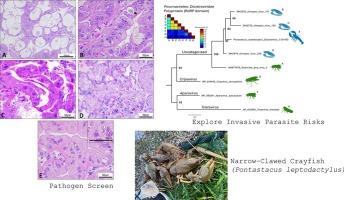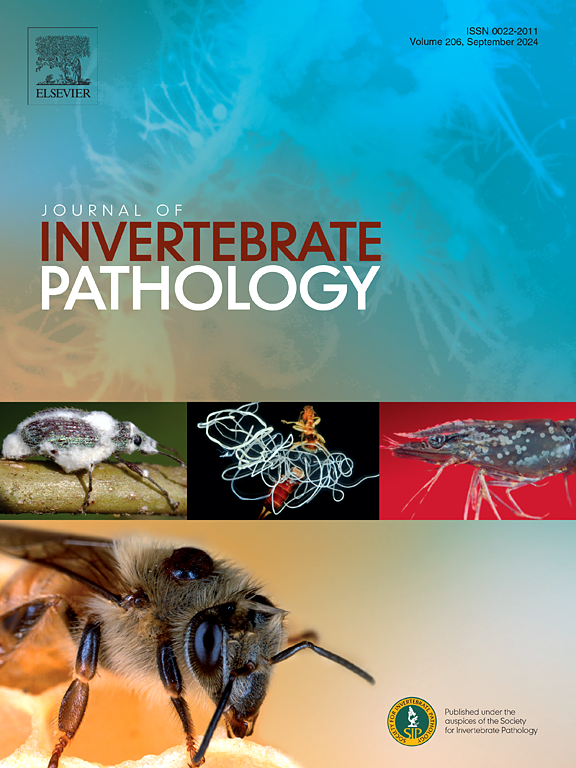Pathogen diversity of the non-native narrow-clawed crayfish (Pontastacus leptodactylus) in a UK water body
IF 2.4
3区 生物学
Q1 ZOOLOGY
引用次数: 0
Abstract
Biological invasions are intrinsically linked to introducing associated symbiotic organisms, some of which can be parasitic or pathogenic. The pathogenic risk of an ‘invasive parasite’ (aka. exotic pathogen) stems from its potential to infect native hosts and induce behavioural change or mortality, with the pathogen potentially presenting a greater risk than the host. Conversely, parasites translocated by invasive hosts may also reduce the impact of their host, indirectly curbing the hosts impact on the invaded ecosystem. In this study, we develop a pathogen profile for the narrow-clawed crayfish, Pontastacus leptodactylus. This is a non-native species in the United Kingdom, and poses a possible risk as a sink for invasive parasites. We use histopathology, metagenomics and metratranscriptomics to outline the symbiotic diversity harboured by a P. leptodactylus population from West Yorkshire, England.
We discovered several protozoan and bacterial species that appear to be putatively commensal with this invader, as well as several RNA viruses (Hepelivirales; Picornavirales; Nodaviridae, and others) that may be more pathogenic in nature. Microsporidia and Nudiviridae were absent in our population sample set, as were all metazoan obligate parasites, such as trematodes and acanthocephalans. Using the novel genomic and pathological data available to us, we have explored the evolutionary history of each symbiotic species and provided an initial assessment on the putative risk to native species.

英国水体中非本地窄爪小龙虾的病原体多样性。
生物入侵与引入相关的共生生物有着内在的联系,其中一些共生生物可能是寄生的或致病的。“侵入性寄生虫”的致病风险。外来病原体)源于其感染本地宿主并引起行为改变或死亡的潜力,病原体可能比宿主具有更大的风险。相反,被入侵宿主转移的寄生虫也可能减少其宿主的影响,间接抑制宿主对被入侵生态系统的影响。在这项研究中,我们建立了窄爪小龙虾,Pontastacus leptodactylus病原谱。这是英国的一种非本地物种,可能会成为入侵寄生虫的聚集地。我们使用组织病理学、宏基因组学和大转录组学来概述来自英国西约克郡的钩足绦虫种群的共生多样性。我们发现了几种原生动物和细菌物种似乎与这种入侵者共生,以及几种RNA病毒(Hepelivirales; Picornavirales; noddaviridae等),这些病毒在本质上可能更具致病性。我们的种群样本集中没有微孢子虫和裸病毒科,也没有所有的后生动物特异性寄生虫,如吸虫和棘头动物。利用新的基因组和病理学数据,我们探索了每个共生物种的进化史,并提供了对本地物种的假定风险的初步评估。
本文章由计算机程序翻译,如有差异,请以英文原文为准。
求助全文
约1分钟内获得全文
求助全文
来源期刊
CiteScore
6.10
自引率
5.90%
发文量
94
审稿时长
1 months
期刊介绍:
The Journal of Invertebrate Pathology presents original research articles and notes on the induction and pathogenesis of diseases of invertebrates, including the suppression of diseases in beneficial species, and the use of diseases in controlling undesirable species. In addition, the journal publishes the results of physiological, morphological, genetic, immunological and ecological studies as related to the etiologic agents of diseases of invertebrates.
The Journal of Invertebrate Pathology is the adopted journal of the Society for Invertebrate Pathology, and is available to SIP members at a special reduced price.

 求助内容:
求助内容: 应助结果提醒方式:
应助结果提醒方式:


